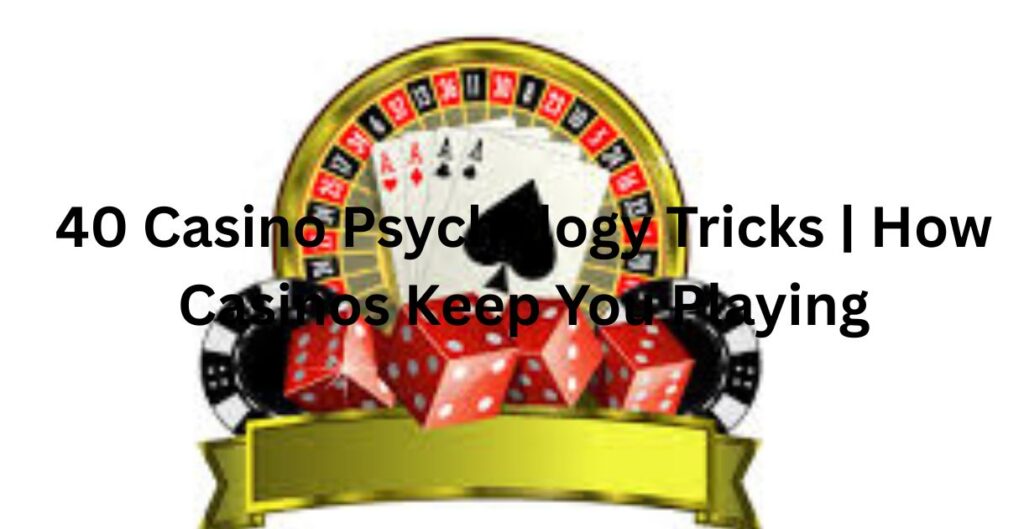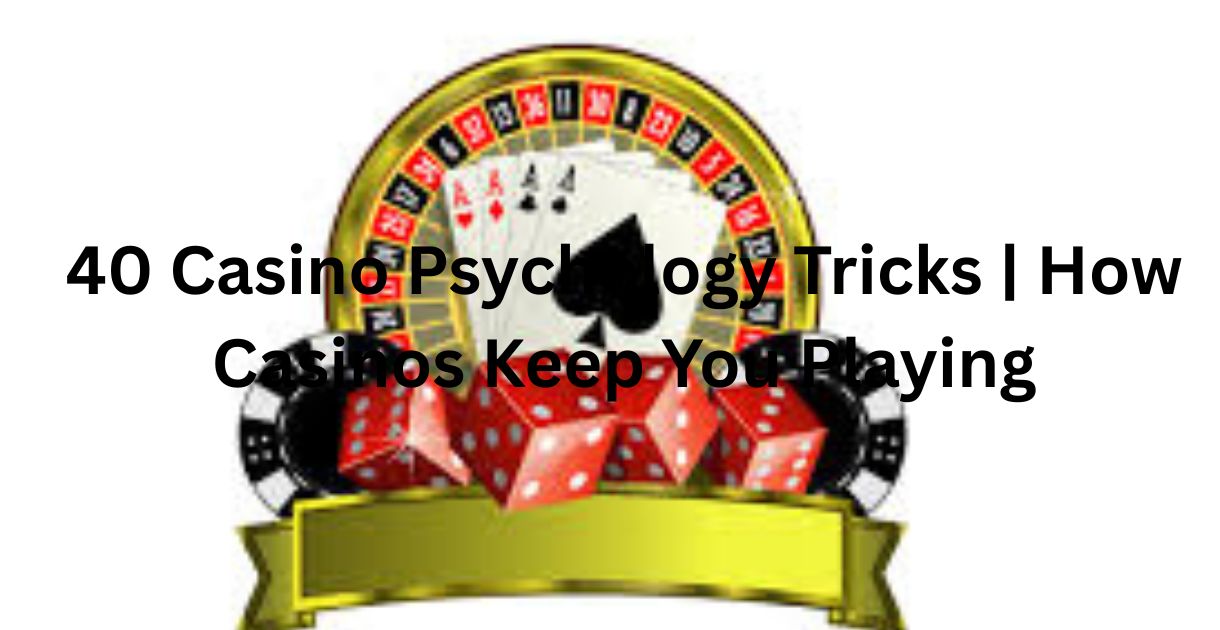Casinos are designed to be more than just places to gamble. they’re carefully crafted environments that tap into our psychology to keep us engaged, entertained, and, often, spending more than we intend. From the moment you step inside, you’re immersed in a world of sensory stimuli, subtle cues, and psychological tactics that influence your behavior. In this blog post, we’ll explore 40 psychological tricks casinos use to keep you playing and how you can be aware of them.

1. No Clocks or Windows
Casinos often lack clocks and windows, creating a timeless environment that makes it easy to lose track of time. Without natural light or time indicators, players can end up spending hours inside without realizing it .
2. Bright, Flashing Lights
The bright, flashing lights of slot machines and other games are designed to grab your attention and keep you engaged. These visual stimuli stimulate the brain’s reward system, encouraging continued play .
3. Loud, Exciting Sounds
The sounds of winning, bells ringing, and machines chiming create an atmosphere of excitement and anticipation. These auditory cues trigger positive emotions, making you more likely to continue playing .
4. Pleasant Scents
Casinos often use pleasant scents to create a comfortable and inviting atmosphere. Research has shown that certain aromas can influence behavior, encouraging players to stay longer and gamble more .
5. Free Drinks
Offering free alcoholic beverages lowers inhibitions and impairs judgment. A tipsy gambler is more likely to take risks and make impulsive decisions that ultimately benefit the casino .
- Also Read This: Captain Jack Casino
6. Maze-Like Layouts
Casinos are designed with maze-like layouts to make it difficult to find the exit. This encourages players to wander through the gaming floor, exposing them to more opportunities to gamble .
7. Near-Miss Effect
Slot machines are programmed to occasionally display symbols that are just one spot away from a winning combination. These near misses activate the brain’s reward system, leading players to feel like they were close to hitting the jackpot and encouraging them to keep playing .
8. Intermittent Rewards
Casinos use intermittent rewards, where wins are unpredictable and sporadic. This pattern keeps players on edge, craving the next win, and encourages continued play .
9. Loyalty Programs
Reward programs are designed to keep you coming back for more, offering perks that make you feel special and appreciated. While these programs can be fun, they can also make gambling feel less risky, leading to a cycle of continued play .
10. The Illusion of Control
Games like craps and video poker give players choices that seem meaningful but have little impact on the final result. This illusion of control can increase confidence and risk-taking, as players believe their skills or strategies can beat the odds .
11. Chasing Losses
The desire to recover lost money can lead to a dangerous cycle of compulsive gambling. This phenomenon, known as “chasing losses,” is a common behavior in casinos .
12. Social Proof
Seeing others win can create a sense of excitement and possibility. Casinos often employ actors to play the role of big winners, further reinforcing the idea that anyone can strike it rich .
13. Variable-Ratio Reinforcement
Slot machines operate on a variable-ratio schedule, meaning that wins are unpredictable and sporadic. This uncertainty keeps players engaged, as they never know when the next win will occur .
14. Color Psychology
Colors like red and gold are often used in casinos because they are associated with excitement, energy, and good fortune. These colors encourage continued play and create an atmosphere of anticipation .
15. Rapid Play
The fast pace of modern gambling games reduces the time players have to reflect, leading to more impulsive decisions and prolonged play .
16. Escalation of Commitment
Once you’ve started gambling, you may feel compelled to continue betting in order to recoup your losses. This escalation of commitment can lead to a dangerous cycle of compulsive gambling .
17. Recency Bias
Recent wins or losses can influence your decisions, leading you to believe that the next outcome will be similar. This bias can cloud judgment and lead to poor decision-making .
18. Confirmation Bias
You may focus on information that supports your belief that you’re due for a win, ignoring evidence to the contrary. This bias reinforces the desire to continue gambling .
19. Illusory Truth Effect
Believing in rituals or superstitions can affect your perception of outcomes. Casinos often capitalize on these beliefs to encourage continued play .
20. Hindsight Bias
After a loss, you may think that different strategies could have changed the outcome. This bias can lead to overconfidence and increased risk-taking .
21. Outcome Bias
Decisions are often based on outcomes rather than the decision-making process. This bias can lead to repeating risky behaviors in the hope of future success .
22. Winning Streak Bias
Confidence from consecutive wins can lead to riskier behavior. This bias can cloud judgment and lead to poor decision-making .
23. Belief in Luck
Initial success can lead to beliefs in luck or personal skill, encouraging continued play and increased risk-taking .
24. Exaggerated Optimism
Overestimating your control over outcomes can lead to increased risk-taking and prolonged play .
25. The Sunk Cost Fallacy
The idea that you should keep investing in something because you’ve already spent time, money, or effort on it can lead to continued gambling, even when it’s not in your best interest .
26. Chasing the Jackpot
The allure of a big win can keep you playing longer than intended. Casinos often display jackpot amounts prominently to entice players .
27. Personalized Marketing
Casinos use AI and data analytics to personalize marketing efforts, tailoring promotions and incentives to individual players to maximize engagement and spending .
28. VIP Programs
Exclusive VIP programs offer perks like higher betting limits and personalized service, encouraging high-rollers to continue playing and spending .
29. Compulsive Play
The design of games and the environment can lead to compulsive play, where players continue gambling despite negative consequences .
30. Emotional Manipulation
Casinos create an emotional rollercoaster that players can’t resist. The close calls—like a ball landing next to the winning number or one card missing for a huge payout—are designed to keep you hopeful .
31. Rewarding Small Wins
Even small wins are celebrated with lights and sounds, reinforcing the behavior and encouraging continued play .
32. Exclusive Events
Hosting exclusive events and tournaments can create a sense of community and belonging, encouraging players to return and continue gambling .
33. Gamification
Turning gambling into a game with levels, achievements, and rewards can increase engagement and encourage continued play .
34. Peer Influence
Seeing others win or enjoy themselves can create a desire to join in, leading to increased participation and spending .
35. Scarcity Tactics
Limited-time offers and exclusive promotions create a sense of urgency, encouraging players to act quickly and continue gambling .
36. Anchoring
Presenting a high initial price or bet can make subsequent bets seem more reasonable, leading to increased spending .
37. Framing
Presenting information in a way that influences decision-making can lead to choices that benefit the casino .
38. Loss Aversion
The fear of losing can lead to riskier behavior, as players try to avoid losses by taking more chances .
39. Overconfidence
Believing that you can beat the odds can lead to increased risk-taking and prolonged play .
40. Addictive Design
The overall design of casinos and games is intended to be addictive, keeping players engaged and spending money over extended periods .
Also Read This: DailyCasino
